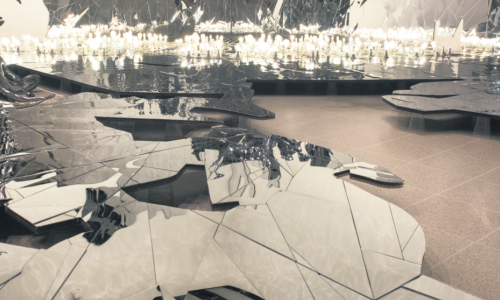Review: Lee Bul: Crashing

Lee Bul’s Crashing is a nightmarish vision of the future, a world in which technology intertwines painfully around flesh, and bejewelled cities leave destruction and sludge in their wake.
The Hayward Gallery’s first room is filled with pink forms erupting with fleshy tentacles. Some show the remnants of humanity – hands poking from within a bloated mass, the vague silhouette of hips – while others are reduced to amorphous blobs. Inspired by Japanese anime, they recall the monstrous entity that appears at the end of Akira. While vaguely reminiscent of Japanese artist Yayoi Kusama’s playful phallic sculptures, Bul’s work has the air of a dreadful prophecy.
Dangling alongside them are pristine white, insectile cyborgs, sprouting frayed clumps of wire, at once elegant and ungainly. Elsewhere human shapes are subsumed into hard, robotic cases, some cast in glazed ceramic, others in faintly glowing resin. Alone in this techno-organic hellscape is a single, lifelike figure of a man, dwarfed by the grotesqueries around him.
The theme of techno-organic integration is continued in Bul’s giant architectural sculptures, which imagine surreal futuristic cities. One floats above a darkened mirror, its metal spires cold and inhospitable. Another sees a black tower growing from a mass of human hair; below is a rolling field of crystals, mined so extensively from the rock below that the entire structure looks set to collapse.
Some of these architectural pieces are a direct response to former South Korean president Park Chung-hee’s building projects in the 1960s and 70s, which borrowed elements of European Brutalism – a slight irony, given this exhibition’s location – to create efficient but ugly and inhuman structures to house the country’s booming population.
The upstairs of the gallery appears to have been entirely lost to the machines. Reflective silver panels cover the ground; penis-shaped airships hang in the sky, and a giant, menacing Zeppelin dominates an entire room, a nod to the Hindenburg disaster and a reminder of the dangers that accompany technological advancement.
It’s a strange and diverse exhibition. Alongside the horrors are more thoughtful pieces: butterflies trapped in resin casts of the artist’s hands; a karaoke booth inside a retro-futuristic car, in which you can enclose yourself and sing along to Meredith Brooks’ I’m A Bitch; a mirrored labyrinth that seems to represent stepping inside the machine itself (an echo of Kusama’s infinity-mirror rooms).
It’s mad and brilliant and unmissable.

